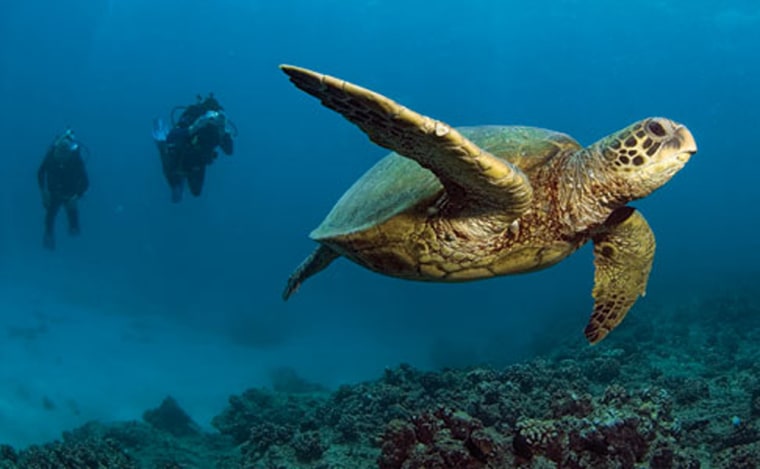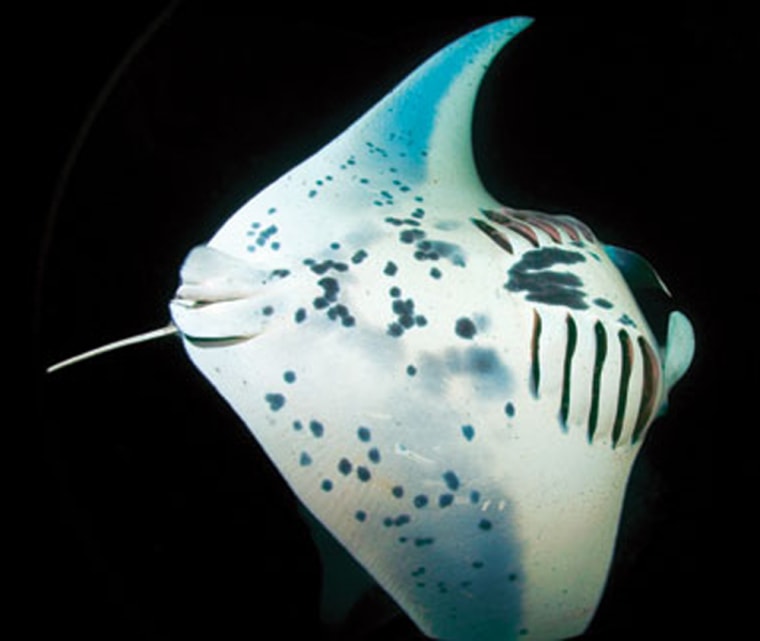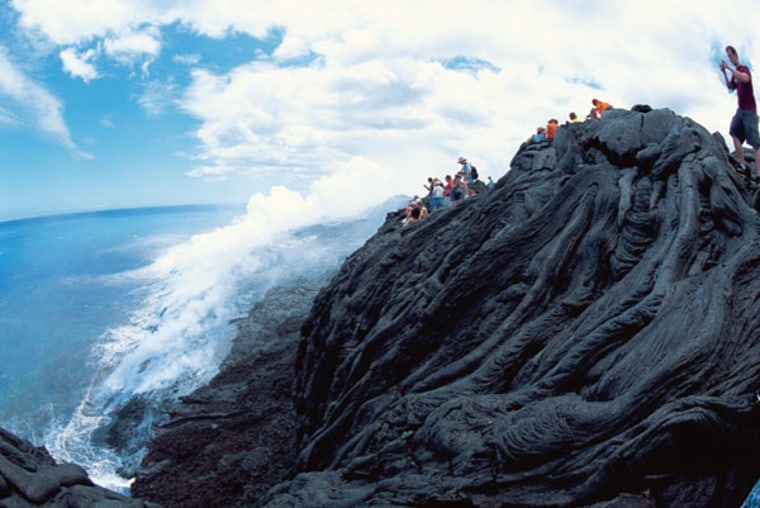Kona keeps you on your toes, keeps you guessing. One day the ocean is full of ethereal whale song; the next day it ripples with the chatter of pods of dolphins and pilot whales. Its waters boil over with superlatives. Giant mantas provide awe and thrill as they swoop and somersault through clouds of plankton, while a fanciful dragon moray will captivate your imagination for years. And then there are the sea turtles. They crowd the beaches at the end of the day and roam from the blue as they’ve done since dinosaurs ruled the earth.
They appear, as if emerging from behind a dark curtain, from the even deeper black of a night sea. A powerful light, placed on the seafloor, fires a beam straight to the surface, where its spreads among the faint evening dapples. The light attracts clouds of plankton. The plankton attract big appetites. On this evening, so many manta rays have heard the dinner bell that it’s impossible to giant-stride off the back of PADI Five-Star Gold Palm Diver Center Bottom Time Hawaii’s 34-foot power catamaran. So, I ease down the ladder and actually get brushed by the wingtip of an eight-footer before I’ve even put my face in the water. The Manta Night Dive, which takes place at Garden Eel Cove on the south coast of Kona, has evolved into one of the most thrilling underwater experiences on the planet, and I can feel the ripple of excitement race up my spine as I descend toward the light, into a melee of wingtips and cephalic fins. The scene is full of the graceful arching, tumbling movements of almost 15 massive manta rays, as they somersault in and out of the plankton stew, mouths agape.
Divers gather in a circle around the main light on the seafloor, dive lights stabbing into the sea hoping to attract a ray to fly over their heads. For as long as we have air, we watch the rays gorge themselves, sweeping in and out of the lights, twirling and swirling like giant carpets caught in a slow tempest. It’s hard for me to pull my eyes away to check my gauge. I don’t want the dive to end. I’ve done this dive about 20 times now, and it has never lost its appeal. I never want it to end, I think, just as a massive ray flies mere inches from my head.
That thought reverberates through my mind on the boat ride back to Honokohau Harbor and in the van to the Outrigger Keauhou Beach Resort in Kailua-Kona, and I try to hold onto the memory of the rays.
After we get dropped off, I wander down to the quiet bay alongside the hotel. A full moon paints the sea and black volcanic rocks that line the shore with a silver sheen. I see a head appear, poking through the surface. Then and only then do I remember why I’d come to Kona in the first place.

This wouldn’t be the first time I’d be thwarted so magnificently on this island of superlatives. From the volcanic outflow to the teeming seas, Kona encompasses cloud forest, rainforest, volcanic desert, lush highlands, waterfalls, green sand beaches and even snow. In the water, 30 percent of everything you see you will only see here. Topside, the rich culture of native Hawaiians has recently re-emerged, and it’s been nurtured and embraced throughout the state. And the spiritual and mythical guardian and guide for all Hawaiians is honu, the sea turtle. Rarely seen in most parts of the world, travelers literally trip over them here on the Big Island, both above and below the water.
A turtle rises
Just before they come ashore, you hear them — exhale, inhale. Deeply. Deliberately, like they’re testing the air, making sure it’s okay to come ashore. All along the coast of the Big Island — from the green sands of South Point to the black sand coves of the Kohala Coast on the western side — green sea turtles rise from their day spent at sea and come ashore to rest for the evening. On Kona, as the Big Island is called, it is impossible to avoid seeing these turtles napping along the shore, dreaming their ancient dreams.
When the Big Island breathed its first breath of air 800,000 years ago — hissing and fighting as it pushed its way up from the deep — green sea turtles were likely wide-eyed witnesses to the event, and probably rested on the first piece of the island that cooled above sea level. For 180 million years, sea turtles have borne witness to the changes in the planet — the dawning of the Ice Age, the extinction of the dinosaurs, the first man, boats, the light bulb. Sea turtles also possess the secret power of navigation in a blue world without mile-markers.
And in those waters, honu are graceful sages. They move with the unhurried ease beasts that have come to terms with the world. And they like a good back scrub. Which is what they get at Turtle Pinnacle — the place to be to encounter sea turtles underwater. Turtle Pinnacle sits just outside of Honokohau Harbor. At night, the turtles pull themselves out of the water at the nearby beach. But during the day, which is when we’re here, they come to a cleaning station in about 45 feet of water and luxuriate as a small platoon of yellow tang and surgeonfish pick parasites and algae off their shells and skin. The sea turtles typically close their eyes, caught in the pure bliss of the moment. They bow their heads and dip their fins, lifting slightly off the seafloor.
When the turtle opens its eyes, our gazes meet. There’s a deep and lyric sentience in those unblinking orbs, a sadness that is singular among sea turtles. As if it is trying to communicate about what the week will bring. But I can’t yet hear its message. It is frustrated by my lack of response.
So for the rest of my week on Kona, the sea turtle abandons me under the water. As if I’m in a watery children’s novel, I ask the gold-spotted eel, the rock-mover wrasse, the flame angelfish, the whitetip reef shark napping in a volcanic cavern filled with dancing light beams, the pod of pilot whales that we encounter between dives and the tiny yellow frogfish about the honu. They all stare impassively, unable to read my thoughts, which I’m sure the honu hears. I see the turtle everywhere — emblazoned on coffee cups up in the rainforest coffee plantations, tattooed on the shoulder of a local surfer, etched into the rock of a freshly dried field of lava and in the shape-shifting clouds — everywhere, that is, except in the water. I find them asleep on the beaches of the Place of Refuge, the Kona Village Resort, next to the Outrigger Keauhou Beach Resort and on the beaches surrounding Honokohau Harbor, backs turned from the lapping waters of the Pacific, chins nestled in the warm black sand, eyes closed as I watch the sun set over their sleeping heads.

I look out over the water, where mantas will emerge from the dark veil, and I know that the next time I slip beneath the blue surface a honu will greet me and tell me once again, if I choose to listen, of the great adventures that wait for me in the Kona sea.
As the official publication of the is the magazine divers turn to each month to find out what’s going on in their world. Sport Diver is the ultimate source for up to date information on dive culture, equipment, travel, training and PADI Diving Society activities.
